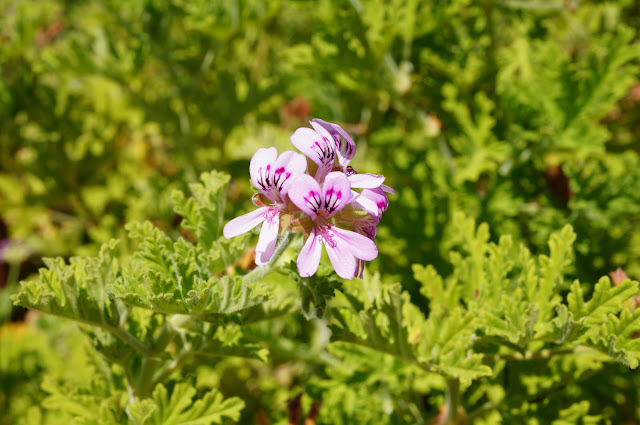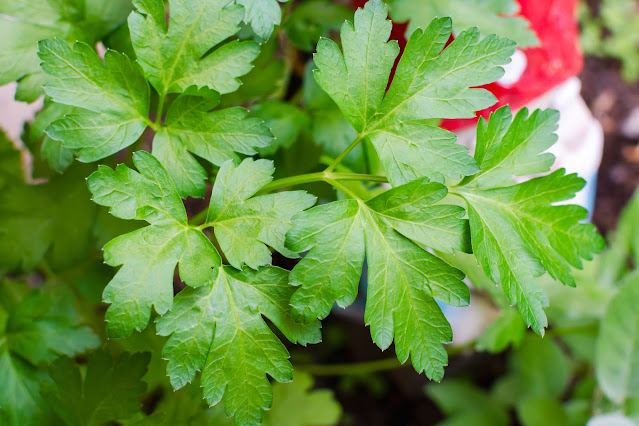April 2024 Plant Sale Plants
The following is a list of the herbs available at the April 20, 2024 Plant Sale.
(Herb beds of member, Judy Hudgins in summer 2023)
Sweet Basil, Purple Basil, Genovese Basil
Basil, in all its forms, is a staple in the kitchen and easy to grow. All basil needs is a sunny spot and moist, well-drained soil. An annual, it is suitable for container and in-ground planting. Keep it growing well during the summer by pinching out the tops of the plants, removing the flowers. This will promote a bushier plant. Basil can be used fresh, as well as dried and stored. The purple basil, placed in a jar of vinegar, makes a beautiful purple vinegar for use in salad dressings. Basil tea is also a refreshing drink during the summer months.
Basil is also a good companion plant with tomatoes, peppers and lettuce.
Once temperatures start dropping, basil will turn black and die. It does not like cool weather. Even in the refrigerator the leaves will turn. For more information on Basil, check here - https://plants.ces.ncsu.edu/plants/ocimum-basilicum/
Bee Balm, Bergamot
Also known by its official name of Monarda, Bee Balm or Bergamot, are a couple of its more common names. Coming in a variety of colors, this perennial loves moist, well-draining soil and sun. However, it can take some shade. Reaching as tall as 4 feet, the only real issue this lovely, easy to grow herb can be powdery mildew.
Native to the North Carolina mountains, bergamot is a great pollinator, attracting bees, butterflies and hummingbirds. With its square stems, it is definitely part of the mint family. While it does spread through underground runners, it can be easily controlled. Dying back in the winter, it will grow back year after year. The flowers are edible and it has uses in herbal medicine.
For additional information - https://plants.ces.ncsu.edu/plants/monarda-didyma/
Borage
With dainty blue flowers, borage is a wonderful addition to any garden. Easy to grow, borage loves sun and does well in poor soil. An annual, it does reseed. The leaves are edible, but the main use is the flowers which are often used as decoration in drinks and on cakes. The leaves, which are hairy, are often used in salads. It is also loved by pollinators and bees.
Plant borage near tomatoes, cabbage, squash and strawberries to deter things like tomato hornworm.
For additional information - https://plants.ces.ncsu.edu/plants/borago-officinalis/
Chives
A perennial workhouse of an herb, chives keep on giving. Sun-loving, chives can take a bit of shade. Loving moist, well-drained soil, chives do well not only in-ground, but also in containers. Chive flowers and stems are both useful in the kitchen. Flowers can be used in salads and when placed in a jar of vinegar, make a lovely lavender colored vinegar for use in salad dressings.
A member of the Allium family, chives have an onion-like taste. When using the stems, cut them back all the way to the ground. They do not regrow if cut mid-stem. Chives make a beautiful and edible mass planting or border in the garden. Cold doesn't bother them too much and can remain useful through the winter. Plus they are attractive to pollinators. Plant as a companion with tomatoes, sunflowers and carrots.
For additional information: https://plants.ces.ncsu.edu/plants/allium-schoenoprasum/
Cilantro
Used in Hispanic and Asian cooking, Cilantro is an herb which prefers the cooler weather in spring and fall. Once hot weather hits, it will 'bolt' and go to seed. Save the seeds! That's coriander. Or save the seed and sow in the garden in late summer for a fall crop of this annual.
Looking a lot like flat-leaf parsley, cilantro has a distinctive taste. Some people think it tastes like soap. While it prefers medium moist soil and full sun, if placed where it can get light shade it will last longer through the summer. The flowers are attractive to butterflies and predatory insects in the garden. Great for interplanting in the vegetable garden where other vegetables will provide some shade.
For additional information: https://plants.ces.ncsu.edu/plants/coriandrum-sativum/
Citronella
Citronella, often referred to as a Scented Geranium, is actually a member of the Pelargonium family.
Not frost tolerant, citronella works best in containers. Do not fertilize heavily as it will reduce the scent in the leaves. Place it where the leaves can be bushed and touched. Supposedly used to repel mosquitoes, citronella makes a lovely addition to the porch or patio.
A perennial, citronella can be saved from year to year as long as it is protected from frost.
For additional information: https://plants.ces.ncsu.edu/plants/pelargonium/
Dill
A versatile annual herb, dill is a taste and scent everyone recognizes. And when it flowers, the seeds can be harvested and used in the kitchen too.
Best known with fish dishes and pickles, dill is a natural companion for cucumbers. Dill grows well in full sun and likes consistent watering, but not sitting in moist soil. Plus, dill is attractive to pollinators, especially black swallowtail caterpillars. Just brushing the plant will release the aroma of 'dill pickles'. And apparently, deer to not like dill pickles, as they don't bother dill, which may make it useful in your garden to keep them away.
A great companion plant with peppers, eggplant and brassicas, it acts as a 'trap' plant for the tomato hornworm. So plant with your tomatoes if you have an issue with them.
For more information: https://plants.ces.ncsu.edu/plants/anethum-graveolens/
Silver Dollar Eucalyptus
Warning: Do Not Eat Eucalyptus!
It is an evergreen tree, however, it will drop leaves to make room for new leaves. But they don't lose them all at one time.
For additional information: https://plants.ces.ncsu.edu/plants/eucalyptus/
Bronze Fennel
A perennial herb resembling dill, bronze fennel has a slightly bronze tone to the leaves and doesn't grow the bulb normally associated with fennel. Used in egg and fish dishes, fennel has a lovely anise, licorice fragrance. Seeds are used in making certain breads and cakes.
Growing 3-5 feet tall, bronze fennel likes sun and rich, well-drained soil. It will tolerate clay or sandy soil once established. Also, once growing well, it can tolerate drought.
Loved by pollinators, especially Black Swallowtail caterpillars, bees also love it. However, like dill, deer don't care for fennel. Since it can self-seed, plant fennel where it might deter deer from the garden, allowing it to naturalize. Companion plant with peas, lettuce and cucumbers.
For additional information: https://plants.ces.ncsu.edu/plants/foeniculum-vulgare/
Lemongrass
One of the mainstays for India and Asian cooking, Lemongrass is a tender perennial in Zone 8a. The leaves have a lovely lemon scent, hence its name. Requiring full sun, it is best grown in a container in order to bring it inside during the winter. Do not allow it to dry out - keep it well-watered over winter.
Lemongrass forms a clump of stems which are harvested for use. While lemongrass is not harmful to humans, it can cause problems for dogs, cats and horses if they eat it.
For additional information: https://plants.ces.ncsu.edu/plants/cymbopogon-citratus/
Chocolate and Orange Mint
Chocolate and Orange mint, like most members of the Mentha family, are an easy to grown herb. Since it does spread by rhizomes, confining the plant in a container may be the best way to grow it unless you want mint everywhere. While it may die back in the winter, it generally will come back the following year.
Part of mints attraction is that it is an easy plant to grow. While full sun does not bother it, mint can take some shade and most soil types. It does prefer well-drained soil and watering. The flowers are attractive to pollinators of all sorts.
Chocolate mint is a hybrid of peppermint and orange mint. The leaves smell like chocolate and depending on the amount of sun it receives, will have a slight red or 'chocolate' tint and is a darker green than other mints.
Orange mint has a bright, citrus scent and when being used in the kitchen, has a slightly less astringent taste. Orange mint can be substituted for most mints in cooking and in teas.
Another companion plant for tomatoes and also peas and brassicas.
For additional information: https://plants.ces.ncsu.edu/plants/mentha-x-piperita/
Italian or Flat Leaf Parsley
Often confused in appearance with cilantro, Italian, or flat-leaf, parsley is a mainstay in the kitchen. Since parsley does not really like our hot temperatures, some shade or being grown indoors works well for Italian parsley. When using parsley, like chives, cut it all the way back to the ground as it does not grow back from mid-stem.
Watering, and allowing it to dry out between waterings, will keep your parsley happy. Pinching off any flower heads will keep the parsley producing all year. Depending on how severe the winter is, parsley can overwinter outside in the ground.
Companion plant with tomatoes, asparagus, chives and carrots as it attracts predator insects.
For additional information: https://plants.ces.ncsu.edu/plants/petroselinum-crispum/
Rosemary
Probably one of the better known herbs, rosemary is a mainstay in any garden. A perennial, rosemary can overwinter well in our area. Sun-loving and can tolerate somewhat dry conditions, if you can, plant rosemary where you can bush against it when in the garden, releasing the fragrance. What rosemary doesn't like is a wet and humid environment. Think Mediterranean!
Flowers of the rosemary plant are loved by pollinators of all kinds. Once the plant has finished flowering, prune back heavily to encourage a bushier plant. And of course, dry what you prune and save to use in the kitchen.
A good companion plant for brassicas, collards, beans, garlic and carrots.
For more information: https://plants.ces.ncsu.edu/plants/salvia-rosmarinus/
Pineapple Sage
Pineapple sage is a great plant to have a child rub the leaves and smell, asking them what it smells like. They can identify 'pineapple' every time.
Showy and a magnet for hummingbirds, pineapple sage is a great addition to the garden. Fairly hardy, it is considered a tender perennial. It may die back in the winter, but can come back the following spring. This plant likes sun and moist, well-drained soil. It can tolerate some drought, but will start dropping leaves when it needs watering. When you start seeing droopy leaves, give it a drink.
Both the leaves and flowers are edible and the leaves are often used to make tea or to add to tea for a hint of pineapple.
For additional information: https://plants.ces.ncsu.edu/plants/salvia-elegans/
Variegated Sage
A lovely addition just in looks to the garden, variegated sage is another tender perennial herb which loves that sunny, dry area of the garden. It will need some protection during the winter. Harvest lightly the first year until more established, sage is also a great pollinator plant. Another plus is deer and rabbits don't like it. Keeping it pruned will encourage a bushier plant.
Companion plant near brassicas, beans, lettuce, and carrots.
For additional information: https://plants.ces.ncsu.edu/plants/salvia-officinalis/
Mexican Tarragon
A substitute for tarragon, Mexican tarragon, with its bright flowers is a great addition to the garden. Loving sun, it can tolerate most soil types, including clay. It is also a tender perennial and may need a bit of protection in the winter. Mexican tarragon is also a great companion plant for tomatoes, as well as most vegetables.
The flowers appear in the late summer/fall. Deadheading will prolong the blooming of these fragrant flowers. Butterflies and birds love the flowers. However, deer doesn't care for it.
Although you can use the leaves and flowers for teas, coloring foods and as a tarragon substitute, the sap of the plant can be irritating to the skin.
For additional information: https://plants.ces.ncsu.edu/plants/tagetes-lucida/
Thyme
An easy-to-grow and a staple in the herb garden, thyme is a workhorse. It can be used fresh or dried in the kitchen and when flowering it is a pollinator magnet. This is another herb which can take the sun and slightly dry conditions. Once again, think 'Mediterranean'. Plus, while it is enjoyed in the kitchen, deer and rabbits don't care for it.
Thyme enjoys a pruning to keep it from getting leggy. The pruned thyme can then be dried for use in the kitchen at a later date. Companion plant thyme with strawberries and brassicas.
For more information: https://plants.ces.ncsu.edu/plants/thymus/
Note: The links given above are from The Plant Toolbox created and maintained by NCSU and Extension Gardeners. It is free for the public to use and is a great source of research based information on plants.




























Comments
Post a Comment